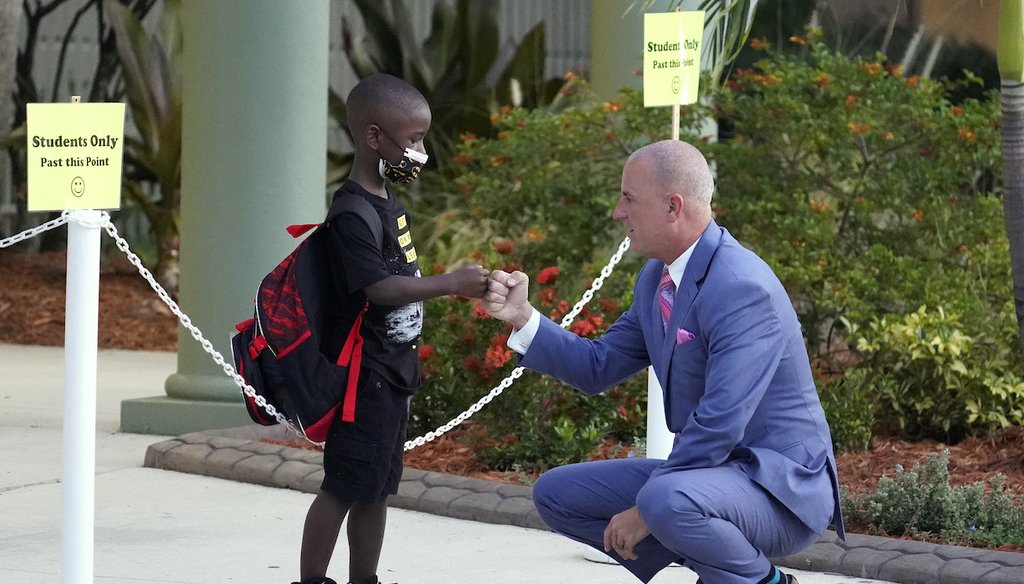Stand up for the facts!
Our only agenda is to publish the truth so you can be an informed participant in democracy.
We need your help.
I would like to contribute

Addison Davis, Hillsborough County Superintendent of Schools, right, fist bumps student James Braden before he heads to class on the first day of school at Sessums Elementary School on Aug. 10, 2021, in Riverview, Fla. (AP)
If Your Time is short
- The spread of the highly transmissible delta variant of COVID-19 will require a new safety calculation, particularly for parents of kids younger than 12, who can’t yet get a vaccine.
- A question on many parents' minds is how to handle the usual coughs and colds that kids exhibit, which now will take on a new degree of importance and concern.
- Experts weigh in on this issue as well as topics such as whether children should regularly be tested for COVID-19, mask-wearing and a number of other frequently asked questions.
When kids head back to school this fall, for some it will be the first time they’ve been in a real classroom with other students since the pandemic began. Even if they attended classes in person last year, the spread of the highly transmissible delta variant of COVID-19 will require a new safety calculation, particularly for parents of kids younger than 12, who can’t yet get a vaccine.
"You have a confluence of three unfortunate events," said Dr. Paul Offit, director of the Vaccine Education Center at Children’s Hospital of Philadelphia. "You have a group of children who are unlikely to have a vaccine available to them when they go back to school; you have the delta variant, which is far more contagious; and you have the winter months, with a cold, dry climate where the virus can spread more easily."
Nearly all schools offered at least some in-person learning by the end of the last school year, and many schools plan to bring kids back full time this fall. And in more than a dozen states, schools are required to offer in-person classes either full or part time, according to an analysis in June by EducationWeek.
Parents have questions about how to navigate this new landscape. Here are answers to some common concerns.
It’s likely your school has protocols in place for handling these situations. But in general, if a child is sick, especially with symptoms of an upper respiratory infection like coughing or fever, keep them home until symptoms subside, doctors said. You should be doing that anyway.
"With the amount of COVID that’s around, parents should definitely keep the child out of school and see their primary care doctor to make sure they don’t have COVID," said Dr. Tina Tan, a pediatric infectious disease physician at Lurie Children’s Hospital of Chicago.
You may want to keep a few rapid COVID-19 tests at home as well. Keep in mind that the results are not completely reliable.
According to an analysis of 48 studies that evaluated rapid antigen tests’ accuracy, among people who had COVID-19, the tests correctly identified the infection in 72% of those with symptoms but in only 58% of those without symptoms. Among uninfected people, the tests accurately ruled out COVID-19 in at least 99% of people, whether or not they had symptoms.
"It’s important to have the ability to do rapid testing," said Dr. Sara Bode, a pediatrician who directs school health services at Nationwide Children’s Hospital in Columbus, Ohio, and helped write the American Academy of Pediatrics’ COVID-19 guidance for schools. "If positive, it allows the school to quickly identify, quarantine and contact-trace. If negative, it allows the child quickly back in school without losing … instructional time."
Once you determine your child doesn’t have COVID-19, keep them home until they have not had a fever for 24 hours and feel well enough to go back to school, similar to the way you would handle any other viral illness. Children infected with COVID will need to stay home for at least 10 days after their symptoms started or, if they’re asymptomatic, 10 days after their first positive COVID-19 test.
"The simple answer is no," Tan said. However, if the child is sick or has been exposed to someone known to have COVID, they need to be tested.
In some school districts, if a child feels sick, nurses can do a rapid test to identify illness. Even if they can’t be tested, students falling ill will likely be sent to a nurse or administrator and separated from classmates.
"School nurses would assess the student, and if they had symptoms of COVID they’d be isolated in a room" until a parent could be called and the student sent home, said Linda Mendonça, president of the National Association of School Nurses.
Yes. "If other people aren’t concerned about the public health risk, that’s on them," Tan said. "But you should do the best for you and your child."
Mask-wearing should not be presented as a big deal, Bode said. Parents can calmly explain that masking is important to keep kids safe at school, and that it’s something the whole family does when they go somewhere indoors.
In areas where masks are optional, ask the school how it plans to handle the issue.
"As a parent, you can advocate for a mask mandate even if [politicians say] you shouldn’t," Offit said.
That’s not necessary. Disposable surgical masks or cloth masks with at least two layers are fine, experts say.
"The best mask is one the child will keep on," Bode said.
According to the CDC and the pediatrics academy, kids don’t generally need masks outdoors, unless they’re in a crowd or near others a long time.
No. Schools figured out safe ways to offer these activities last year and can do so again this year, Bode said. In these situations, it’s important that schools create layers of risk protection, she said. Practice outdoors if possible, and make sure students remain at least 3 feet apart.
Special masks for singers fit tightly around the face but bow out to leave more room for children to project their voices, she said. Likewise, there are masks with openings for band members’ mouths and also covers to catch droplets that might escape from the open ends of instruments.
No. "At first, it looked like a virus that would spread on surfaces," Offit said. "But now we know that it is primarily transmitted through respiratory droplets."
Even if kids can’t get the COVID-19 vaccine, make sure they’re current on the rest of their shots, Tan said.
"We’ve seen a significant decline in the number of kids who aren’t up to date on routine immunizations," Tan said. Avoiding outbreaks of vaccine-preventable illnesses is key to a healthy school year.
Our Sources
Source links in story.



























